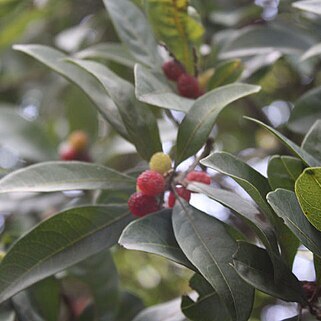Small tree, 3-15 m high; trunk crooked, irregu-larly branched; bark grey. Branchlets usually mod-erately densely clothed with patent, longish, less often short, thin hairs, mixed with scattered sessile yellow glands, sometimes hairless and more or less densely glandular only. Leaves lanceolate, lanceo-late-obovate or oblong-obovate, from a gradually narrowed, acute, narrowly rounded or (young trees) narrowly cordate base, acuminate or not, with an acute or rather acute, less often obtuse apex, on adult trees entire and firmly coriaceous, on the upper surface with or without minute yellow glands, beneath bearing many caducous minute glands which leave a shallow pit on falling off, ciliate or not, either thinly pubescent on both surfaces (especially on larger nerves), or only beneath, or quite glabrous, shining darkgreen above, on adult trees 2½-15 cm by 1-4½ cm (for very young trees see beneath); midrib strongly prominent beneath; lateral nerves on either side of midrib 5-15, obliquely erect or ascending from a patent base, inarching near the margin or not, prominent beneath. Petiole firm, pubescent or glabrous, 2-10 mm. Flowers (♂)(♀). ♂: inflorescences solitary in the leaf-axils, erecto-patent to widely patent, 3-8 cm long (short peduncle included). Rachis thin, usually rather densely clothed with more or less patent, longish or short white hairs, between the hairs with scattered yellow glands, sometimes hairless and glandular only, bearing several rather remote, at last widely patent catkins; catkins singly in the axil of a triangular, 1½-2½ mm long, hairy bract, sessile or shortly stalked, ½-1½ cm long, dense or rather lax; their rachis patently hairy. Floral bracts ovate-triangular, patently hairy on the back, ± 1 ¼ mm long. Stamens 4, rarely 3, very rarely 2; filaments connate at the base into a column ¼-½ mm long; anthers distinctly or hardly stalked, vertical, contiguous, thick, red, beset with numer-ous very short, comparatively thick hairs, ± ¾ mm long; no rudimentary ovary. ♀: Inflorescences solitary in the leaf-axils, erect or more or less widely patent, 1½-5 cm long, simple. Rachis thin, mostly clothed with patent longish or short hairs, mixed with scattered yellow glands, sometimes hairless. Catkins in the lower part remote, higher up often crowded, placed singly in the axil of an ovate-triangular, hairy, 1¼-3 mm long bract, ses-sile, 1½-2 mm long, consisting of 10 or fewer densely crowded flowers. Floral bracts ovate-triangular, acute, hairy and glandular, ± 1½ mm long. Bracteoles very minute, ovate-triangular, pubescent, ±⅓ mmlong. Ovary hairy when young. Styles at last spreading or reflexed, filiform-subulate, hairy at the base, ± 2½ mm long. Berries red, 1-3 per catkin, ellipsoid, beset with broadly rounded tubercles, red, ± 1 cm long.
More
Trees evergreen, dioecious, usually (2-)4-10 m tall; trunk to 40 cm d.b.h.; bark gray. Branchlets and buds tomentose. Petiole 0.3-2 cm, pubescent to tomentose; leaf blade narrowly elliptic-obovate or lanceolate-obovate to cuneate-obovate, 4-18 × 1.5-4.5 cm, leathery, abaxially pale green, dark punctate, occasionally sparsely golden glandular, adaxially dark green, rarely glandular, pubescent along midvein, base cuneate, margin entire or sometimes serrate in apical 1/2, apex obtuse to acute. Male inflorescences much branched, erect or pendulous at apex, 4-9 cm; individual spikelets to ca. 1 cm; peduncle densely pubescent; bracts overlapping, ciliate and usually golden glandular. Male flowers without bracteoles. Stamens 3-7; anthers red, ellipsoid. Female inflorescences erect, 1-3.5 cm, many flowered; flowers in short, axillary fascicles well spaced at maturity; rachis densely pubescent and golden glandular; bracts ciliate, golden glandular. Female flowers with 2 bracteoles, ciliate and golden glandular. Ovary velutinous; stigmas 2, bright red. Drupes many per infructescence, red at maturity, usually ellipsoid, papilliferous. Fl. Aug-Feb, fr. Nov-May.
An evergreen tree. It grows to 4-12 m high. The trunk is 40 cm across. The bark is grey. The trunk branches early and in usually not straight. The young branches are hairy. The leaves have stalks. The stalks are 0.3-2 cm long. They are hairy. The leaves are 3-15 cm long by 1-4.5 cm wide. They are sword shaped but broader near the base. They are dark green on top and paler underneath. There can be teeth along the edge towards the tip. The flowers are of one sex. The male flowering cluster is much branched and are erect but can hang over at the tip. They are 4-9 cm long. The female flowering stalks are erect and 1-3.5 cm long with many flowers. They are greenish or slightly red. The fruit is oval and red when ripe. They are edible.

